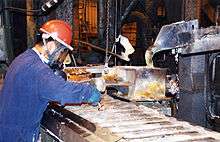Occupational toxicology
Occupational toxicology is the application of the principles and methodology of toxicology to understanding and managing chemical and biological hazards encountered at work. The objective of the occupational toxicologist is to prevent adverse health effects in workers that arise from exposures in their work environment.[1]
The science of toxicology has many applications. One of these, relates to exposure of people to noxious or hazardous agents during the course of their work.

Occupational toxicology is the study of the adverse effects of agents that may be encountered by workers during the course of their employment.[3]
The work environment has played a significant role in the occurrence of adverse human health effects due to chemical and biological hazards for centuries.
Occupational health specialists, including toxicologists, rely upon human and animal data to determine safe exposure levels. If effects observed in workers can be reproduced in a laboratory animal, it becomes possible to investigate the mechanisms that might reasonably be expected to produce such effects. On the other hand, shedding light on the mechanism by which a designated effect is produced in a test animal species may make it easier to find ways to prevent such effects from occurring in humans. Such an understanding may also help to identify subtle or delayed effects that have not been observed in workers, but to which health professionals should be alerted.[4]
Exposure
Occupational exposures involve situations ranging، for example from a secretary using typewriter correction fluid to the loading and off-loading of tanker trucks with thousands of gallons of gasoline.
History
Early writings by Ulrich Ellenbog (1435–1499), Agricola (1494–1555), and Paracelsus (1492–1541) revealed the toxic nature of exposures in mining, smelting, and metallurgy. A systematic treatise by Ramazzini (1633–1714) described the hazards as they applied to miners, chemists, metal workers, tanners, pharmacists, grain sifters, stonecutters, sewage workers, and even corpse bearers.[1]
How is occupational toxicology used?
- Role in decision making within hierarchical control
- Role in setting exposure standards for workplace chemicals
- Role in biological monitoring for chemical exposure[5]
References
- 1 2 Casarett and Doull’s ,TOXICOLOGY, The Basic Science of Poisons
- ↑ Brodkin, E; Copes, R; Mattman, A; Kennedy, J; Kling, R; Yassi, A (2007). "Lead and mercury exposures: interpretation and action". Canadian Medical Association Journal. 176 (1): 59–63. doi:10.1503/cmaj.060790. PMC 1764574
 . PMID 17200393.
. PMID 17200393. - ↑ Occupational Toxicolog, 2nd EDITION, Edited by Chris Winder and Neill Stacey
- ↑ PRINCIPLES OF TOXICOLOGY , Environmental and Industrial Applications , SECOND EDITION , Edited by Phillip L. Williams,
- ↑ Occupational Toxicolog, 2nd EDITION, Edited by Chris Winder and Neill Stacey
